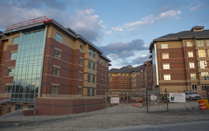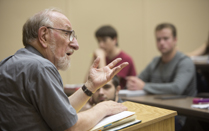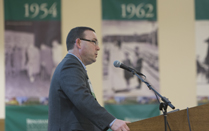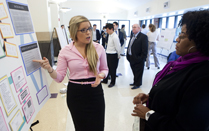Binghamton University President Harvey Stenger's quarterly report - June 30, 2013
This quarter has been a very eventful one, highlighted by the successful launch of our Road Map. I like to say that the development of the Road Map, as well as the journey it will lead us on, is comparable to taking a long drive in the family station wagon. Planning the trip and charting our course on the map are only the first stages — the real fun begins when it’s time to get in the car and drive.
And now we’ve hit the road. In April, Binghamton University held the public launch of our Road Map, the strategic plan that will guide us as we become the premier public university of the 21st century. Much of our work this past quarter has been geared toward the Road Map’s objectives; certainly in terms of the steps we’ve taken in implementing our strategic priorities, but also in terms of changes in campus leadership and organization, community outreach, and new directions in educational programming and research. As you read the reports from the various divisions you will see that the University is committed to meeting the challenges of the coming decades with enhancements to our international programs, targeted faculty hiring, improvements to our buildings and grounds, and better living and learning experiences for students.
At the same time, I have been busy these past three months addressing a number of senior personnel changes and restructuring some divisional responsibilities. My goal in making these changes is to help us advance quickly on several crucial Road Map priorities, particularly with regard to our efforts to strengthen our research and educational objectives. And of course, I have also been very busy meeting with political officials, alumni, local business leaders and other constituents whose support and involvement are crucial to the University’s success.
So the journey has begun. With the Road Map laid out before us, we can now see our path, and, if this quarter is any measure, we are making progress toward becoming the premier public in a steady and expected way.
Road Map Implementation Launch
The most meaningful event of the quarter, one that will change the direction of the campus for a decade or more, occurred on April 8, when approximately 350 faculty, staff, students and community members joined together as Provost Nieman and I publicly presented the Road Map to Premier: A strategic Plan for our Future. The plan is an ambitious one, designed to help us move from being very good (where we are now) to being great.
In my remarks at the launch, I emphasized the transparency and open-endedness of the Road Map process, in which the final destination wasn’t preordained, but was decided by the participants themselves.
Key to the Road Map are the five strategic priorities that developed out of the planning process — each completing the sentence: “The premier public university of the 21st century will . . .”
The priorities are:
1. Engage in path-breaking graduate education, research, scholarship and creative activities that shape the world.
2. Provide a transformative learning community that prepares students for advanced education, careers and purposeful living.
3. Unite to foster a diverse and inclusive campus culture.
4. Enhance the University’s economic, social and cultural impact through engagement from the local to the global level.
5. Optimize the acquisition and allocation of human, technological, financial and physical resources.
Under each of these are several projects that align with the strategic priority — such as increasing institutional support for interdisciplinary research under strategic priority no. 1 and establishing a “Global Center” for international engagement under priority no. 4. All told, there are 43 projects that will be funded this year in support of the Road Map.
To ensure that we continue to meet our benchmarks for progress, we are configuring the Road Map steering committee to work in five teams − one for each strategic priority. The teams will start meeting in the fall. In the meantime, I have prepared their charge, tasking them with maintaining a high level of excitement and momentum, as well as overseeing campus progress on each of the strategic priority projects.
In order to have the broadest representation possible, I have expanded membership on the steering committee to include representatives from the Alumni and Foundation boards, along with the deans of our schools. They will be responsible for evaluating the progress of all projects for their strategic priority and making recommendations for course corrections. In this work they will be assisted by three graduate interns. Together, they will work to ensure that important project milestones are met and that the projects stay on track to completion.
The University has committed significant dollars (drawn from resources from NYSUNY 2020 and other operational funds) for each of our strategic priorities. We are fortunate that this year’s budget is one of the best in Binghamton’s recent history. While there were some moderate tuition increases provided through NYSUNY 2020, it is important to note that all of the resources generated by these increases are flowing directly to the University, where they are being used to hire new faculty and fund new academic programs.
The budget also recognizes the University’s plan to gradually increase student enrollment through 2017, and we are on target to meet our goals for next year. (We have been especially successful in recruiting graduate students for next year – growing by about 140 graduate students to a total of over 3,100 – which has been one of my priorities for the University since it is crucial to the development of our reputation for research and scholarship.) Overall, the campus 2013-14 budget plan is balanced based on our revenue and expenditure projections.
In Vice President James Van Voorst’s report, you will read about the progress the University has made with new construction. This year marks the culmination of a multi-year building phase at Binghamton University, with new residence halls, dining halls, research and learning spaces rising across campus. Construction will continue as these projects are brought to completion.
These new facilities are designed to help us meet the educational and research goals outlined by the Road Map. In addition, we are hiring new faculty to teach our students in these new classrooms and to produce cutting-edge research in our new laboratories. The hiring enabled by NYSUNY 2020 marks one of the most significant faculty hiring campaigns in our history, increasing by 25 percent in just five years the number of researchers and scholars at Binghamton.
In the most recent two years, we have hired 48 new tenure-track faculty, as well as 13 full-time lecturers (6 in Harpur, 7 in Watson), to meet critical teaching needs. Faculty hires have been concentrated in the areas of energy and health sciences, though all schools have experienced some hiring.
The hiring of approximately 150 new tenure track faculty over the course of the NYSUNY 2020 plan will reduce the University’s student to faculty ratio and add to graduate education as well as research and scholarship output. Importantly, the hiring of faculty under the plan is being organized into clusters so we can maximize the scholarly and educational impact of each new faculty member.
These clusters, which we call Transdisciplinary Areas of Excellence (TAEs), are organized around broad thematic and socially complex questions that can only be answered by drawing on the perspectives and techniques of faculty from a multitude of disciplines, including the natural, social and physical sciences, humanities, and the professions.
Working with faculty drawn from across the campus, Provost Nieman identified five TAES that draw on many of the University’s traditional strengths, even as they push us in new directions of productive research and scholarship that correspond to the changing needs of our society. The five TAEs are:
• Citizenship, Rights and Cultural Belonging;
• Health Sciences;
• Material and Visual Worlds;
• Smart Energy;
• and Sustainable Communities.
In addition to forming the basis of cluster hiring and an explosion of related research, these TAEs will produce interdisciplinary courses that will push students’ education in innovative directions. The TAEs will also be the starting point for national symposia and conferences that will raise the University’s visibility and reputation in these related fields.
New Deans and Campus Reorganization
The past three months, coinciding with the end of the academic year, have seen the departure and hiring of several senior personnel at the University. In March, we announced the appointment of a new dean for Harpur College: Dr. Anne McCall, a scholar of 19th-century French literature and, for the past five years, dean of arts, humanities and social sciences at the University of Denver. Before becoming dean at the University of Denver, McCall taught at Vassar College and Tulane University. She is the recipient of Tulane’s Excellence in Undergraduate Teaching Award and is a past president of the George Sand Association.
Her background in the liberal arts and sciences, her experiences in international education and her extensive leadership experience are very impressive. McCall will assume her duties on Aug. 1, 2013.
I regret that Dean Patricia Ingraham, founding dean of the College of Community and Public Affairs, announced her retirement effective June 12, 2013. Dean Ingraham had a profound influence on the directions of the college and has been instrumental in developing many of the community partnerships that distinguish the college and the University. Provost Nieman has appointed Laura Bronstein, professor and chair of the Department of Social Work, as interim dean.
The spring quarter also saw a reorganization of my senior leadership team. In June, Vice President for Academic Affairs and Provost Donald Nieman was named executive vice president for academic affairs and provost, with authority to answer many of the day-to-day questions that come before the president’s office. This is a common arrangement among top universities that will serve us well as we grow in size and scope, as projected by our Road Map.
In another change in University structure, as of July 1, the Division of External Affairs is being reorganized and will now be known as the Division of Advancement, focusing on alumni relations, development and philanthropy. I have appointed Rebecca Benner as interim vice president, pending a national search for a vice president scheduled to begin in the fall. As part of this reorganization, the Office of Communications and Marketing will now report to the executive vice president for academic affairs and provost, where it can better focus on promoting our academic and research programs, help recruit outstanding students and faculty, and brand our institution as the premier public university.
Commencement and Alumni Leaders
This quarter also marked the introduction of Binghamton’s latest alumni. In May, the University held its spring commencement ceremonies. More than 3,000 students received degrees from our six schools, including 90 doctoral and 589 master’s degree recipients. Each school, as well as the three divisions of Harpur College of Arts and Sciences, held individual, personal commencement ceremonies in which each student walked across the stage as his or her name was read. We also held a special hooding ceremony for doctoral candidates. In talking with graduates and their families, it is clear that they value the special recognition the new commencement program provides.
Commencement would not be worthy of the name unless it included the awarding of honorary degrees. This year, honorary doctorates were awarded to pioneering pilot, educator and philanthropist Marilyn C. Link; scientist and inventor Voya Markovich; preeminent social worker and champion of the homeless Nancy Wackstein; and scientist and scholar George Whitesides. In addition, actor, writer and director Ruben Santiago-Hudson ’78; attorney Linda Reifberg ’81; and physicians Lisa Benson, MD, BS ’81, MA ’83 and Lee Guterman, MD, PhD, BS ’81, MA ’83 were recognized by Harpur College with alumni awards; and John Lyons ’94 was recognized by the School of Management with an alumni award during their respective school and division ceremonies.
This quarter also saw the first Binghamton University Alumni Leaders Conference, with more than 200 active alumni returning to campus to attend sessions meant to inform them about the Binghamton University of today and inspire them to get involved further. Sponsored by the Alumni Association, and working closely with a wide variety of campus leaders, the conferees learned about University research and how it’s financed and received updates regarding each of the University’s schools.
In my talk, I described the Road Map and my goals for the University 5, 10 and 20 years out. I encouraged our alumni to think about what they could do to help us become the premier public. Culminating the conference was the featured speaker at the Alumni Awards Ceremony — Hakeem Jeffries ’92, the first Binghamton University graduate elected to the U.S. Congress. This was his first visit back to campus since being elected to Congress last November and he gave a very stirring speech to the gathered alumni.
I also had the opportunity to meet with a group of alumni on the other side of the country — members of the University’s Bay Area alumni chapter in San Jose, Calif. Currently more than 2,000 Binghamton alumni call the San Francisco region home, and many of them were on hand to reconnect with fellow alumni and learn about the new directions of the University. In addition, attendees also benefited from a presentation by Dean Krishnaswami “Hari” Srihari and graduates of the Watson School, who told the audience about the many ways their education at Binghamton has led to successful careers.
Governor’s Visits and the REDC
Binghamton University has been honored to host New York state Gov. Andrew M. Cuomo several times over the last few weeks, when he has been in the region to promote his economic development plans and good government. Touting his START-UP NY proposal, Cuomo signed the bill into law in the rotunda of the University’s Innovative Technologies Complex. We are fairly confident that there will be a significant boost to commercial and industrial work in the buildings surrounding our University Downtown Center and the forthcoming high-tech incubator.
On July 1, Gov. Cuomo returned again to campus to announce establishment of a 25-member Moreland Commission to investigate corruption in state government. Alumnus Gerald Mollen ’74, Broome County district attorney, will serve on the commission. Binghamton appreciates that the governor has selected us for such high-visibility announcements as it helps bring recognition to our campus as a place that gets it done — and gets it done right.
This visibility should help the area as we prepare for the third round of Regional Economic Development Council Meetings (REDC). As you recall, last December the Southern Tier Region received a $91-million economic development package and a “Best Plan” Award. Binghamton continues to host periodic REDC meetings as we develop our next proposal and to follow up on benchmarks for our previous proposals.
Indeed, it has been a productive quarter – with steady progress and no major surprises.
Sincerely,

Harvey G. Stenger






